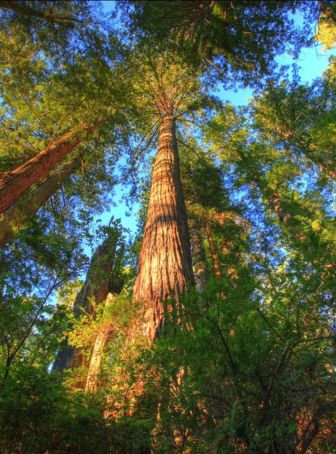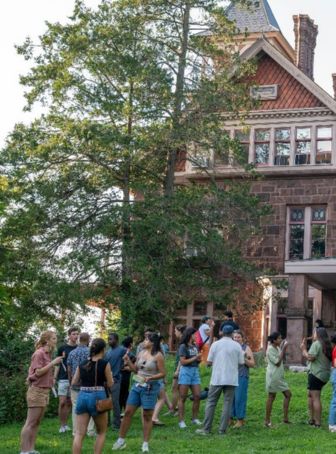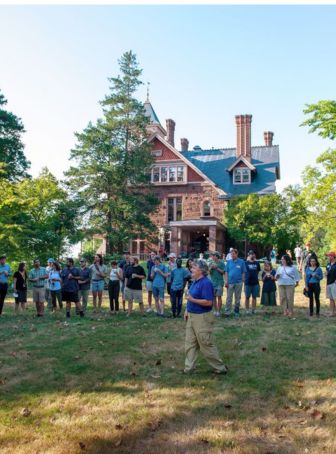
Jess Jones ‘23 MF
Trees are ancient beings. Their histories stretch over 300 million years into the past, and our human ancestors’ descent from their branches is a comparatively recent affair. Trees witness Earth changes beyond our comprehension. What might trees have learned in their hundreds of millions of years on terra firma, and what can we learn from them? Authors Peter Wohlleben (The Hidden Life of Trees), Sumana Roy (How I Became a Tree), and Jessica J. Lee (Two Trees Make a Forest) discussed this and more with our moderator, Co-founder and Director of the Yale Forum on Religion and Ecology Mary Evelyn Tucker, in the webinar On Trees. Together, we considered trees as philosophical, spiritual, and relational guides.
Over 4,000 people registered to attend the event. On Trees is the second webinar of its series hosted by The Forest School at the Yale School of the Environment, the Yale Forest Forum, Orion Magazine, Yale Forum on Religion and Ecology, and Yale Environmental Humanities. The series celebrates the recent release of Orion’s anthology Old Growth.
As thousands of registrants express, people are hungry to integrate our scientific understandings of the environment with humanity’s never-ending quest for meaning. The two are not at odds! In their crux lies the opportunity to expand into new ways of knowing and being. Trees can guide us in this expansion. Trees build environments and communities as they purify the water and air while also housing countless plants and animals. This strategy has worked for quite some time.
How can we learn from the trees? Our authors suggest that first, we must slow down. 21st century life is instant, overwhelming, seemingly without pause! In How I Became a Tree, Sumana Roy sought an escape from calendar time and our human emotional economies. Disturbed by the troubles of humanity, she searched for a new way of being to embody. A ceiling fan, perhaps? She found their lack of agency a turnoff. Maybe a dog – ah yes, but they are just as tied to the household’s emotions as any human. Trees, Roy decided, were the paradigm. Trees have the agency we hold dear, yet none of the social hang ups. And forget calendar time. Trees exist in tree time. A long-lived tree compresses our human decades into just several rings. It stands sentinel to the centuries.
Across space-time, groups and individuals have crafted nuanced understandings of trees. This is our philosophical inheritance, Roy beautifully illustrates in her explorations of the Indian literary and scientific traditions. For example, the sacred texts of the Upanishads highlight the life in everything. How might such a philosophy free us to recognize our kinship with the world? Do not we respond like the tree to the drifting clouds, noted by Indian botanist Jagadish Bose to dapple the light?
Wohlleben remarks we often see trees as objects. Possibly this is because they live unhurried. I mean, can anything that slow even be alive? Wohlleben explains how we rush them with fertilizers and push them with pruning — anything to fit a tree into our timelines and aesthetics. It seems unscientific to consider what the trees could ‘want.’ But it’s obvious. They want to live. So much of our ‘progress’ has centered on the desires of the select few. And to what end? In listening to trees better, we can learn to listen to one other as well. Trees teach us that listening is beyond prodding, poking, pushing. Listening is to be with.
Trees communicate all the time. One listening tool we have is our nose. That’s right – whenever you go out in the woods, your nose is intercepting the chemical messages trees cast into the air. A scent may say, Warning! Bark beetles. The surrounding trees increase their defenses with a flare of phytochemicals. Wohlleben talked us through these codes and whispers of the canopy.
Tapping into collective knowledge, Jessica J. Lee discusses the power of passing on names. Through names, we share what we value. A tree is a tree, but a maple is a source of sugar. The lodgepole pine is excellent firewood. The Bodhi tree is the place of the Buddha’s enlightenment, and the olive tree’s branches symbolize peace. Lee writes of visiting the land of her mother’s family, Taiwan. She finds that the environmental history of Taiwan shaped the personal and political realities of the place. Language opened her up to this understanding – her mother and grandfather gave her the linguistic tools to know the trees of Taiwan. In recognizing the trees, she recognizes the environment as more than her story’s backdrop. It is the foundation that channels colonial histories and familial shifts, as a river does water.
What are trees beyond their material use to us? Mary Evelyn Tucker astutely notes Wohlleben’s characterization of trees as a community, and not a commodity. In his work, and that of Lee and Roy, we are invited to learn from these communities — about living, about ourselves, about beauty. Trees also feel, and they take care of each other. We misunderstand survival of the fittest, Wohlleben says. It’s not about dominance or exploitation. It to fit in the best way you can – what you, with your unique gifts, can contribute.
The last thing we want to do is overlook the patterns scientists have worked so hard to decipher. Many are reasonably concerned that anthropomorphizing the trees and the forest does just this. Yet others believe different ways of knowing can complement each other. In art and literature, we can freely explore beyond the ‘hyper-rational’ boundaries constraining modernity– resource economics, the scientific method. Maybe you feel, as I feel, as we believe On Trees attendees feel, that there is an affection and fondness due to our ancient allies. Our longstanding relationship with the trees deserves a place in the modern world. It is place we can co-create.
To watch the captioned recording of the On Trees event, please visit here.







